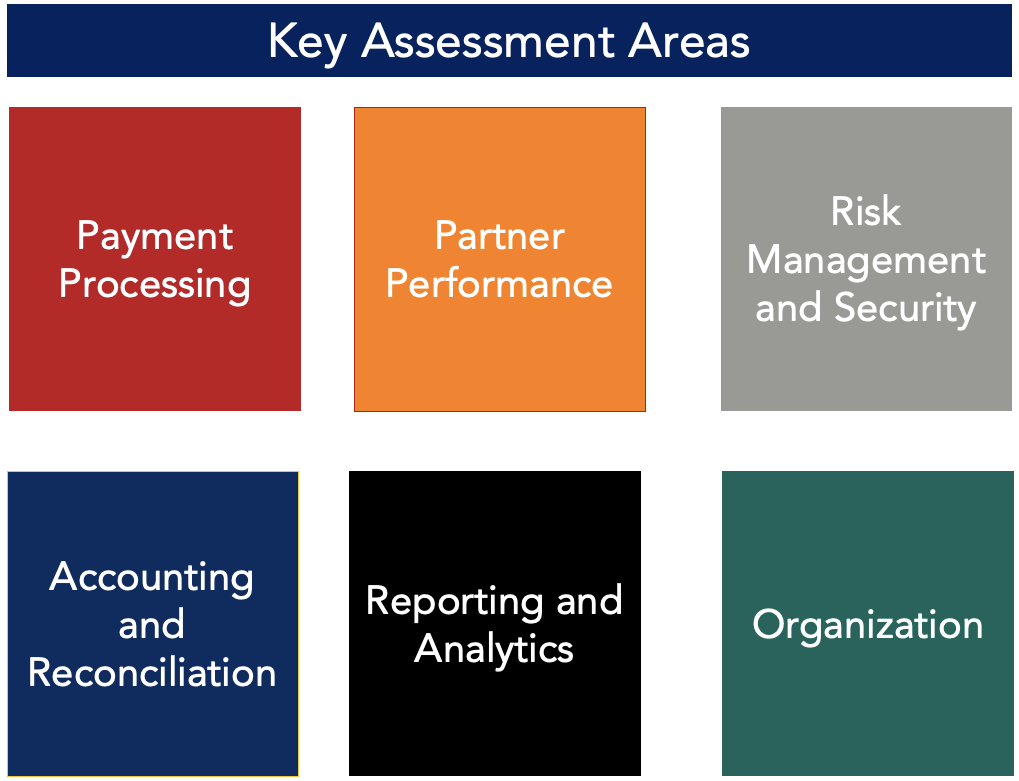I am often asked if Glenbrook Partners is a payments education company, and if I teach. My answer to both is yes. Our education programs are designed to give attendees a stronger payments foundation on which to build and refine their corporate strategies, product development efforts, and operational functions.
We’re also very much a payments strategy firm. Here, I will focus on some of the ways we help merchants improve their payments strategy and operational effectiveness.
First, we like to take a deep dive into a merchant’s current setup. We take a comprehensive view of a broad range of elements, such as company and payments roadmaps, payments KPIs (key performance indicators), customer pain points, and more. We become as intimate with the merchant’s payments business as possible to develop an inside view while maintaining our outside perspective.
The key assessment areas that we focus on are:

Core Payment Processing
Architecture. Glenbrook assesses payments architecture for its ability to scale up volume and support new methods of payment, new business lines and geographies. We examine the use of third-party providers in the system, and internal or external gateways, with a bias towards a service-oriented architecture. We also look for any critical points of failure that can affect system availability and consequently customer conversion.
Operations. We evaluate the core functions that support the ongoing management of the payments business including customer support, site reliability engineering (SRE), and back-office operations related to disputes and fraud management.
Conversion. A customer’s smooth and successful completion of a purchase is the goal of a merchant’s payments operations. However, friction at the point of interaction may result in decreased conversion, lead to loss of revenue for the merchant, and a poor customer experience. Analyzing the end-to-end checkout flow is critical to identifying areas of opportunity, in both the customer experience and back-end payment processing.
Partner Performance Assessment
The main focus here is to assess whether the incumbent payment providers are acting as good partners to the merchant. This can take many forms across a broad array of indicators including account management support for commercial, product, and operational needs. Our assessment of partner performance may lead to the addition of a new payments provider in order to install a champion-challenger model. We may recommend going to RFP to swap out a currently under-performing provider.
Developmental Stages of Merchant Payment Operations
There are three distinct stages of merchant payments evolution:
- “Get me going”– This phase, typical of startups, just about getting paid. Providers like Braintree and Stripe serve young, developer-focused companies through quick and simple to onboard and integrated solutions, complete with comprehensive documentation, self-help support, and straightforward integration and operation.
- “Help me scale”– After cutting its teeth in payments, the merchant now has built its business, and, if the stars have aligned, is experiencing the sweet taste, and tribulations, of high growth. What does scale look like now? It could take many forms: the obvious volume growth, geographic expansion, or even the addition of new lines of business.
- “Help me optimize”– Armed with war stories, and the wiser for it, these merchants desire to generate new efficiencies from their payments business units, often asking questions such as:
- Am I using payments as a competitive moat?
- Are my operations best in class?
- How do I rate myself against other comparable businesses in the industry?
Glenbrook helps merchants in the latter two stages of their payments evolution. No matter where you are in your payments journey, however, it’s important to step back periodically and check to see if the engine simply needs an oil change or if a major overhaul is in order.
Risk Management and Security
We look to understand a merchant’s risk appetite, architecture, common vulnerabilities, and controls. Each merchant’s risk profile is unique, and the optimal structure for managing risk varies across vertical and company size. We assess the organization’s risk management IQ, key risk metrics, use of third party vendors, and operational processes.
Accounting and Reconciliation
Critical back office functions, these important steps ensure that partners are crediting the merchant as promised, that the books on refunds and chargebacks are balanced, and that partners are charging the merchant appropriately. We probe to assess the types of reconciliation performed and review exception management processes.
Reporting and Analytics
It is often said, “If you don’t measure it, you can’t manage it”. Transaction processing cost, user conversion rates, and platform health metrics are important KPIs that must be monitored to effectively manage a payments operation. Depending on the nature of the business, unique KPIs may be required.
Organizational Structure
One of Glenbrook’s partners likes to identify who the merchant’s “payments czarina” is, the individual who champions the best interests of a company through the strongest possible payments offerings. Well-intentioned firms often identify this role informally; the best have it formalized. Clear ownership of success metrics in the areas of customer Net Promoter Score, revenue growth, and profitability is necessary to run a successful payments business. In general, we look for dedicated support across all payments functions to maximize efficiencies and increase competitive strength.
While we assess more aspects of a merchant’s business, this post illustrates the key areas we know are essential to merchant payments operations. In the weeks and months ahead, we’ll take a deeper dive into each of these areas.
Is there a particular area that interests you that you’d like to learn more about? Feel free to reach out. Of course, your comments are welcome!


